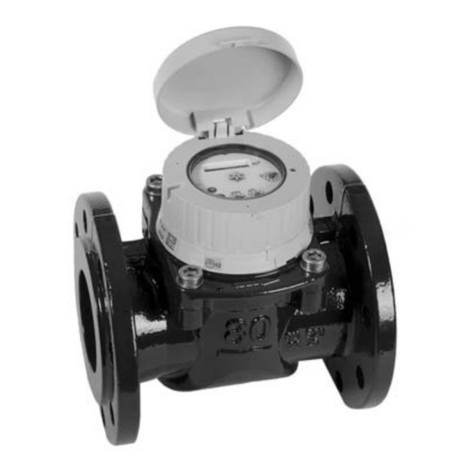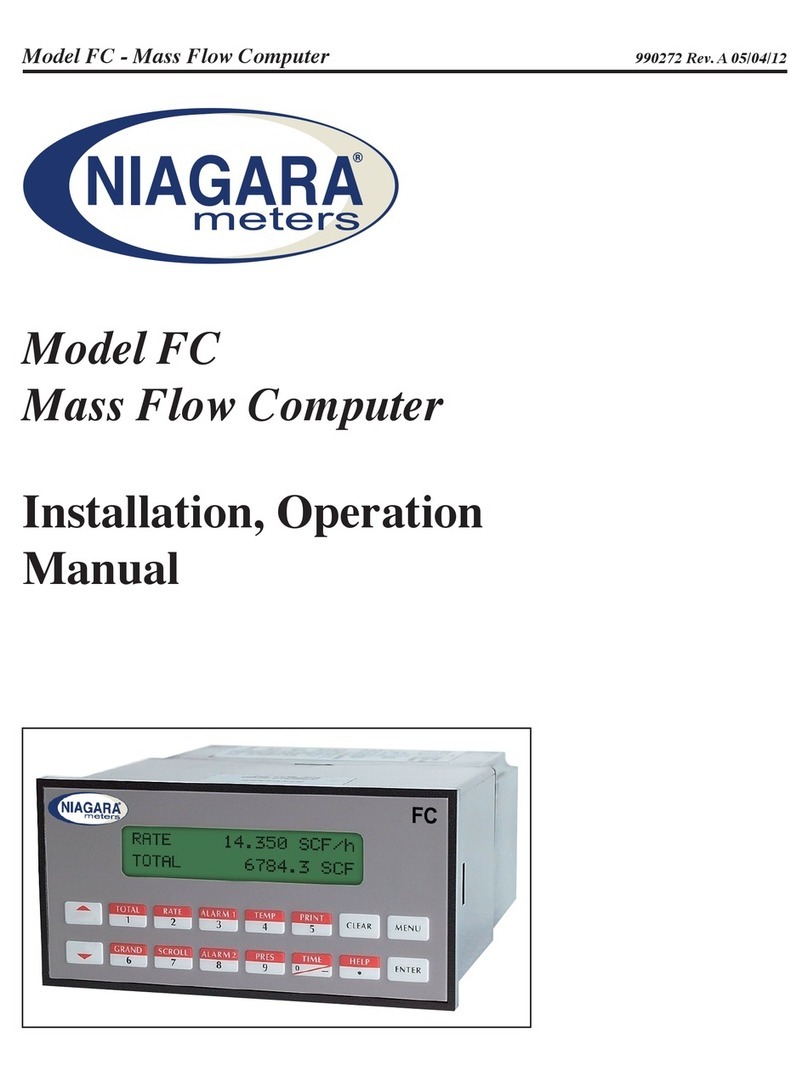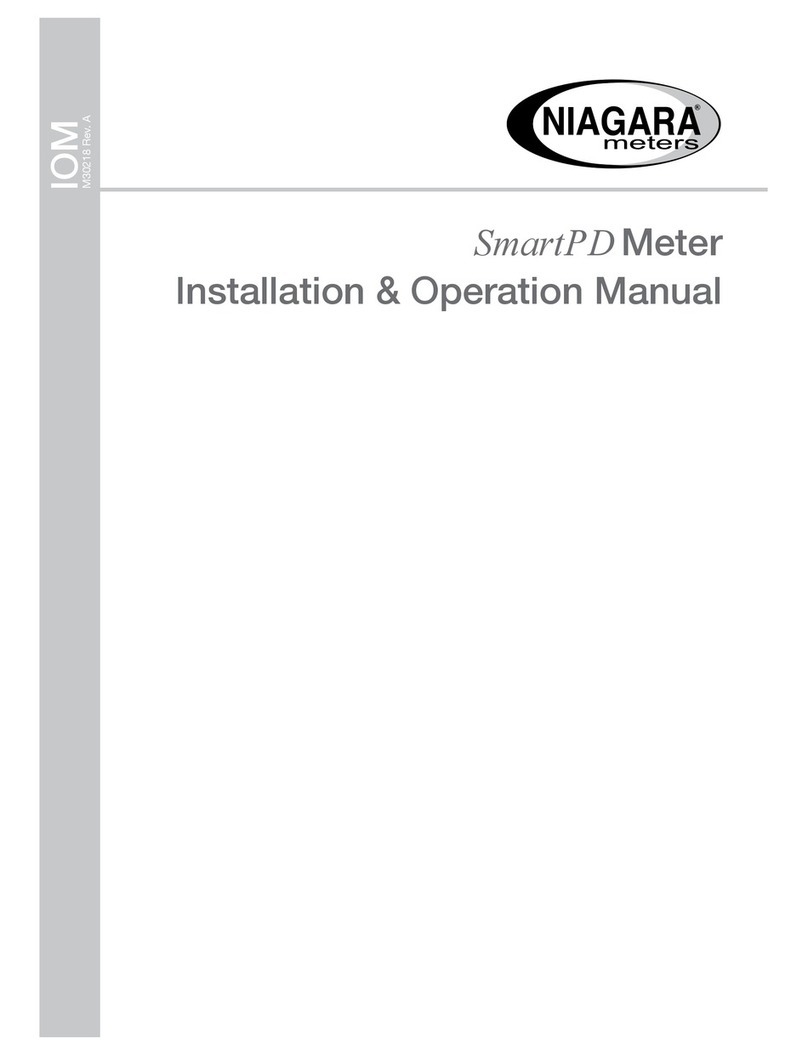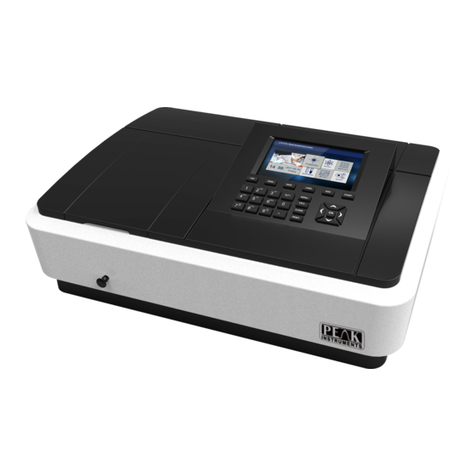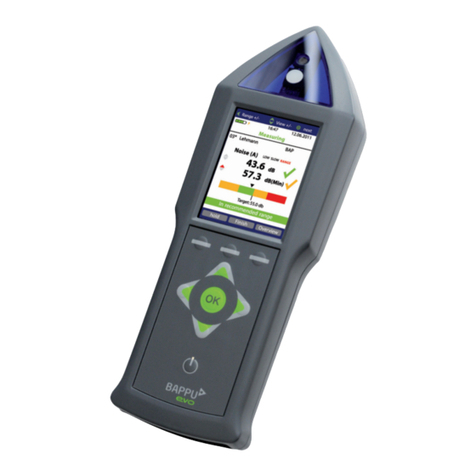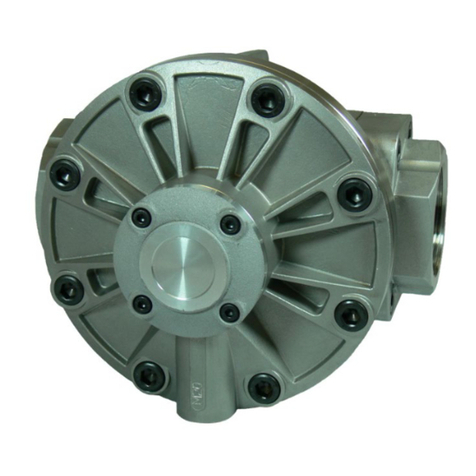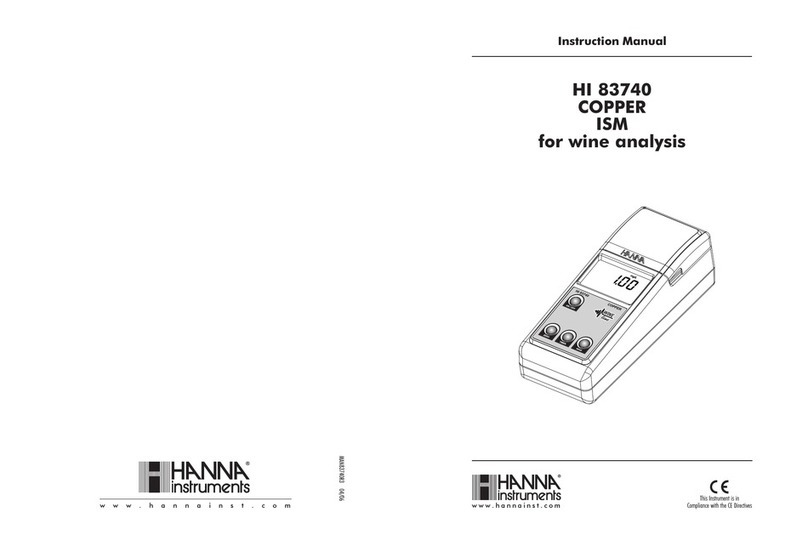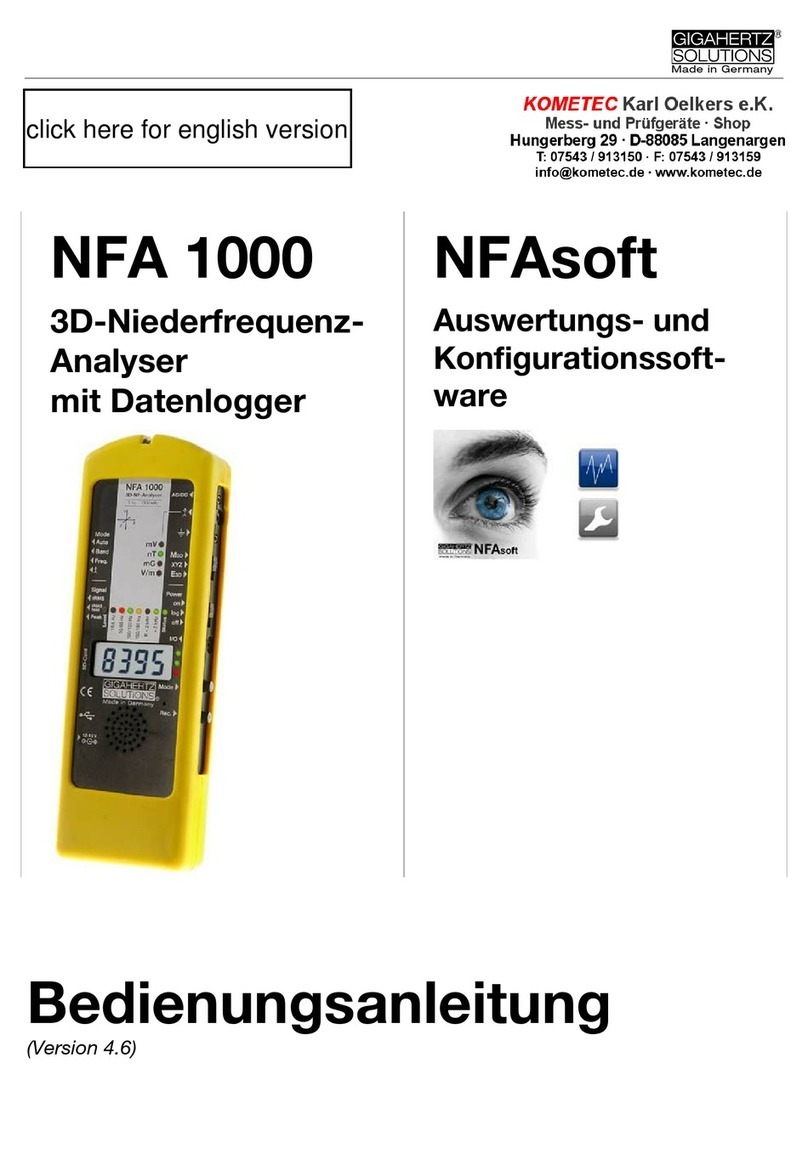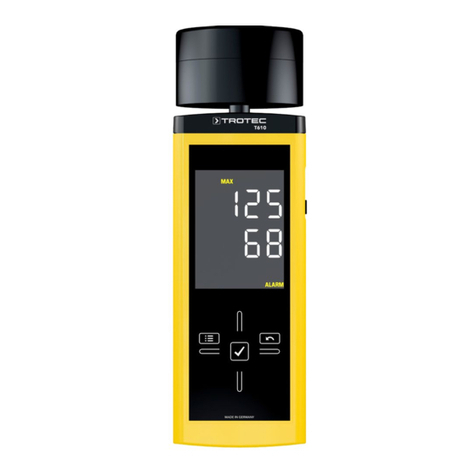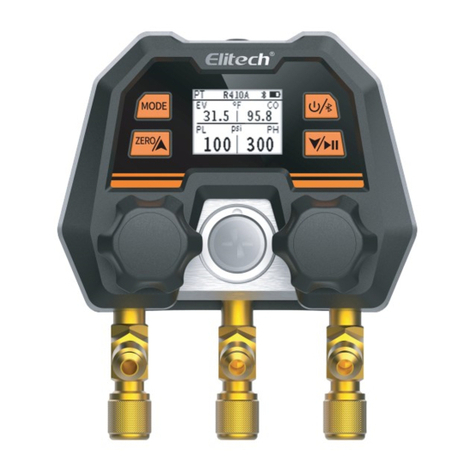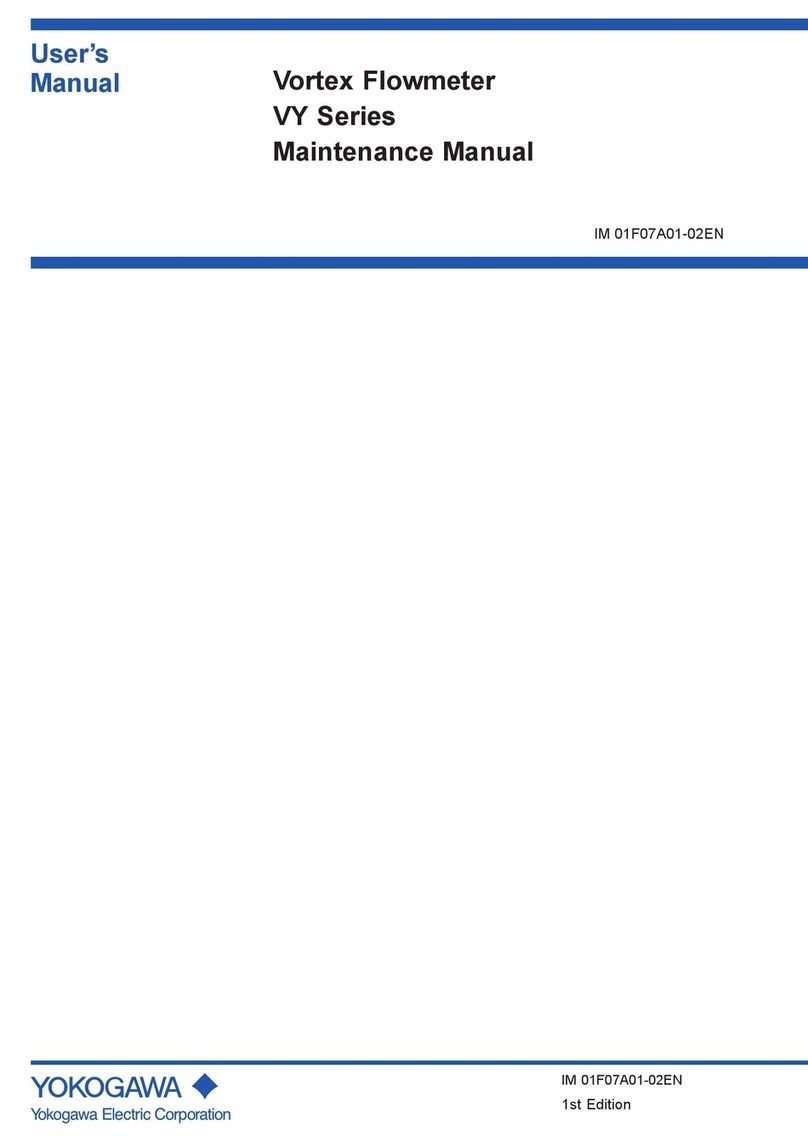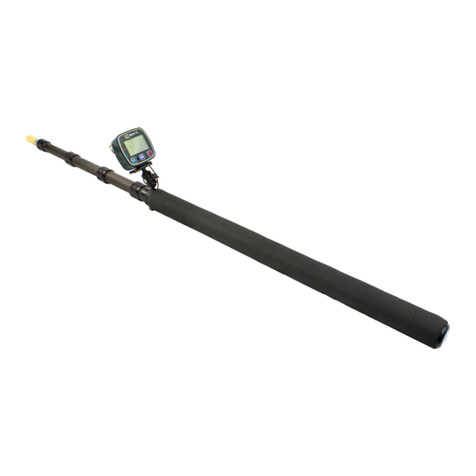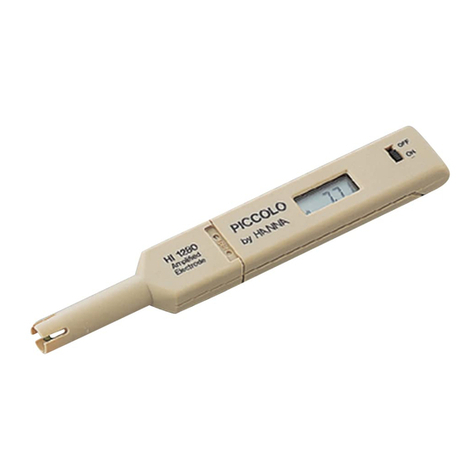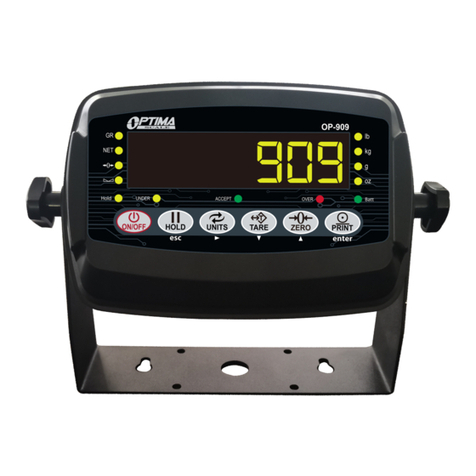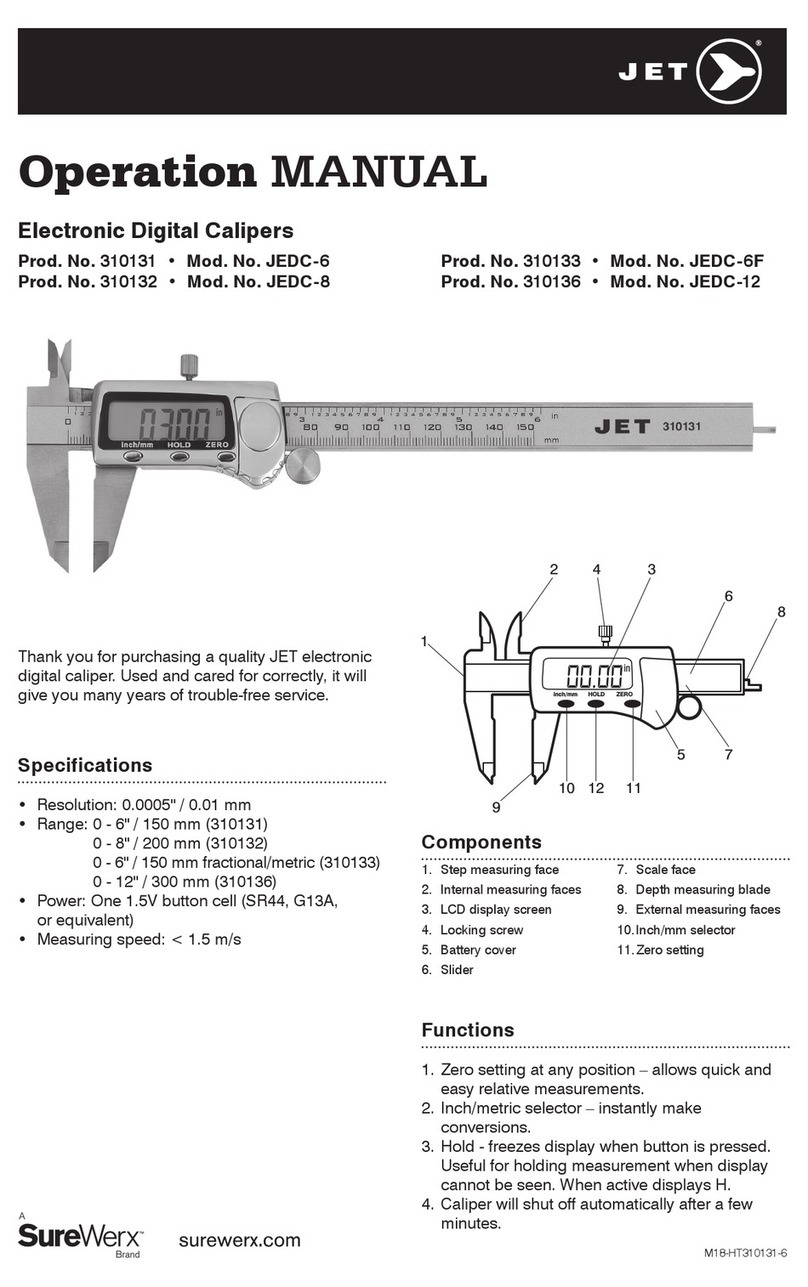Niagara 6600 Series Instruction manual

®
meters
NIAGARA
INSTALLATION,
OPERATION &
MAINTENANCE MANUAL

The following symbols are used in this operation manual or instrument and this should be inter-
preted correctly as given against each symbol.
1
2
3
4
5
6
Number Symbol Description
Direct Current
Alternating Current
Earth (Ground) Terminal
Protective Conductor Terminal
Caution (Refer to accompanying documents)
Caution (Risk of electric shock)

1.0PRODUCTDESCRIPTION PAGE
1.1 Function 1
1.2 Applications 2
1.3 Principal of Operation 2
1.4 Model Code Identification 5
1.5 Technical Specifications 6
1.6 Dimensions 9
2.0HANDLING&STORAGE
2.1 Inspection and Handling 15
2.2 Storage 17
3.0MECHANICALINSTALLATION
3.1 Guidelines 17
3.2 Mounting 19
4.0ELECTRICALWIRING
4.1 Guidelines 21
4.2 Connection Information / Wiring Diagram 22
5.0SET-UP&PROGRAMMING 28
6.0MAINTENANCE 38
7.0DIAGNOSTICMESSAGES 39
8.0TROUBLESHOOTING 40

Installation, Operation & Maintenance Manual M600 NIAGARA
The 6600 Series is a low cost, Electromagnetic Flowmeter that combines ease of use and reliability to accommodate
a wide range of applications.
In the standard 6600 Series of Magnetic flowmeters, the SENSOR and the ELECTRONICS form one mechanical
entity. In the optional high temperature version for temperatures up to a maximum of 248° F (120° C) or for fluid
temperatures exceeding 176° F (80° C), the electronics are remotely mounted, and can be installed up to 330 feet
away from the sensor depending on conductivity.
The SENSOR consists of a metering tube, electrodes and coils. The electrodes and coils are in a welded fully
encapsulated sheet metal enclosure that is filled with polyurethane. This prevents the internals of the sensor from
becoming exposed to moisture and environmental conditions. The SENSOR rating with integrally mounted
electronics is IP67 (protection against entry of dust and low pressure jet of water from all directions, NEMA 4X), with
Remote Electronics IP67 (protection against entry of dust and submersion in water, NEMA 6P).
The conditioning ELECTRONICS circuitry is housed in a cast aluminum box with IP67 (protection against dust and
limits submersion to 3.2feet/1 meter, NEMA 6) protection. The termination of the electronics is given in an adjacent
cast aluminum housing with ½-inch NPT fittings for the required interface cables
The flanged meter is available from 1/2 to 24 inch sizes. Hastelloy Stainless Steel electrodes (150#,carbon steel
flanges) are standard, but several other electrode materials such as 316SS, Titanium, Monel, Platinum Rh etc. are
available.
The 4-20 mA output proportional to flow can be fed to a PLC, DCS or remote mounted indicator. An optional 24 V
DC pulse or frequency output can be connected to external devices such as a totalizing counter.
The complete instrument consists of a sensor and a controller.
The sensor consists of the metering pipe, electrodes and magnetic coils. It is encapsulated in a fully
welded sheet steel enclosure that is filled with polyurethane to prevent exposure to moisture and environmental
conditions.
The controller contains the electronics that is used for driving the magnetic coils, conditioning the
electrode signal and providing the outputs. It may be mounted integral with the sensor or on a wall.
In the compact unit, the controller and the sensor form a single mechanical entity.
Electronics
Sensor Steel

NIAGARA Installation, Operation & Maintenance Manual M600
In the remote version, the controller and the sensor are separate and are interconnected using a
special cable that is supplied with the instrument.
The electromagnetic flowmeter is used to measure the flow of conductive liquids and slurries a low as 5 Micro
Siemans (including corrosive and abrasive) in closed pipes. The performance of the instrument is not affected by
the properties of the material such as corrosiveness, viscosity, pressure, density, acidity and alkalinity. It can
measure the flow of liquids, pastes and slurries in water, wastewater, chemical, fertilizer, dairy, food, beverage,
pharmaceutical, medical, petrochemical, iron, steel, paper, mining and agricultural industries, etc.
They are used to measure water flow cooling in steel and power plants. They have the ability to measure flow of
clean water, effluent, sludges, etc., in pollution and environmental control.
These meters offer an obstructionless, maintenance free alternative to mechanical flow devices. The 6600 series of
electromagnetic flowmeters offer the user economical flow monitoring using pulsed DC technology. The design
allows quick and easy installation without the need for skilled personnel and is virtually maintenance free.
A conductive fluid flowing through a magnetic field generates a voltage proportional to its' velocity. Electrodes sense
the voltage for transmission to the electronic converter. A simple calculation using the cross sectional area of the
flowmeter provides the volumetric flow.
Electronics
(Wall Mounting)
Sensor

Installation, Operation & Maintenance Manual M600 NIAGARA
The principle of operation is based on Faraday's law of Electromagnetic Induction. In an Electromagnetic flowmeter,
the liquid passing through the device represents a conductor moving through a magnetic field. It induces a voltage
perpendicular to both the magnetic field and the direction of flow. The voltage is linearly proportional to the mean
velocity as is represented in the following empirical equation:
e = l*B*v Where, e = Induced Voltage
l = Conductor Length
B = Magnetic Field Strength
v = Velocity of the conductive fluid
The voltage generated is detected by a pair of insulated electrodes as the conductive liquid moves through the
magnetic field.
l :The length corresponds to the distance between the electrodes. The internal distance between the electrodes
inside the measuring pipe remains constant for a particular model.
B :The strength of the magnetic field is constant by design for a particular model and meter size.
e: The induced voltage is therefore linear in a relation with the pipe internal diameter, strength of the magnetic
field and the mean flow velocity. With l and B being constant for a particular size, the voltage generated (e.m.f.) is
directly proportional to the mean flow velocity.
Voltage e (e.m.f. generated ) α v (velocity)
Since, v = Flow Rate / Cross sectional area => Q in ft3/min / (π x Di2/(4x144))
Where Di = Internal Pipe Diameter Inches
Substituting in the main equation:
e = l x B x Q in ft3/min / (π x Di2 /(4 x 144)) => Q x l x B x 4 x 144/ (π x Di2)
Variable Constant
Therefore, for a given nominal diameter or cross section, the e.m.f. generated is proportional to flowrate, i.e.
e (e.m.f. generated) α Q (volumetric flowrate)
B
l
v
e = l.B.v e
l
B
v
Where, = I
nduced Voltage.
= C
onductor Length.
= M
agnetic Field Strength.
= C
onductor Velocity.

NIAGARA Installation, Operation & Maintenance Manual M600
For any electromagnetic flowmeter to work reliably, it is therefore extremely important that the measuring tube is
completely full, which by default can be achieved easily through vertical mounting of the flowmeter. Hence a vertical
upstream installation is preferred.
Electromagnetic flowmeters can be installed in vertical, angle or horizontal mounting positions, as long as the pipe
remains completely full. The electrode axis in such installations must be kept in the horizontal plane.
To increase the signal to noise ratio, the magnetic field is pulsed. During the pulse period, voltage is induced at the
electrodes. During the off period, the generated voltage is zero. During this off pulse, any signal voltage is
interference (noise). This voltage is subtracted out and stored by the electronic circuitry (auto zero). During the
pulse period the stored interference voltage noise is subtracted and cancelled out by the electronics circuitry yielding
only the true generated signal that is being induced by the fluid moving through the meter. The auto zero occurs
several times a second insuring an automatic positive reference as to zero flow.
The induced voltages are amplified using differential amplifiers with high input impedances to minimize the effect
from any electrode coating. The amplifier gain is adjusted using R-ref in such a way that the flowmeter gives a 20
mA output current for maximum flow range. The current output can be used for remote indication and or recording
purposes.
To compensate for any fluctuations of the magnetic field intensity, the current passing through the coils is measured.
The magnitude of this current increases or decreases the frequency output on the amplifier card. This frequency is
used to generate the 4-20 mA current output. Pulse Outputs and Relay Outputs corresponding to High and Low
Alarms are generated by the micro controller.
All program data is stored in NVRAM. Even in the case of power failure, programmed parameters are retained by
the NVRAM.
Data entry is accomplished by activating Hall Effect switches using a magnetic commander.

Installation, Operation & Maintenance Manual M600 NIAGARA
Line Size
00.5 ½”
01.0 1.0”
01.5 1.5”
02.0 2.0”
03.0 3.0”
04.0 4.0”
05.0 5.0
06.0 6.0”
08.0 8.0”
10.0 10.0”
12.0 12.0”
14.0 14.0”
16.0 16.0”
18.0 18.0”
20.0 20.0”
24.0 24.0”
Electrode Material
H Hastelloy C (standard)
S 316L Stainless Steel (optional)
T Tantalum (optional)
P Platinum-Rh (optional)
M Monel (optional)
Mounting Connections
0 150# ANSI Flange
1 300# ANSI Flange (½ to 4”)
1 300# ANSI Flange Carbon Steel (6.0" - 8.0")
2 150# ANSI Flange Stainless Steel (0.5" - 4.0")
2 150# ANSI Flange Stainless Steel (6.0" - 8.0")
2 150# ANSI Flange Stainless Steel (10.0" & above)
Liner Material
T PTFE (Teflon) 0.5" - 6.0"
T PTFE (Teflon) 8.0" - 12.0"
R Hard Rubber (Ebonite) (8.0" - 24.0")
R Hard Rubber (Ebonite) (3.0" - 6.0")
Electronics
0 Integral
1 Remote (330ft max; specify cable length)
Power
A 90VAC - 265VAC, 50/60 Hz
If you require more than the standard 15ft cable, order part number 60524P010.

NIAGARA Installation, Operation & Maintenance Manual M600
Fluid Types Conductive Liquids > 5μS/cm
Fluid Pressure 150 PSI, Consult factory for higher ratings
Fluid Temperature PTFE (Teflon): -4 to 176 F Integral
PTFE (Teflon): -4 to 248 F Remote
Hard Rubber (Ebonite): 32 to 158 F
Vacuum Limits Consult Factory
Low Flow Cut-Off Set at 0.164 ft/sec(typical)
Magnetic System Pulsed DC
Voltage 90VAC to 265VAC, 50/60 Hz
Outputs 1. Current - 4-20mA DC; 800 ohms max
2. Pulse - Open collector 24 VDC; 200
ohms min load, programmable “on” time
from 1 to 99msec.
1 Pulse = The least significant digit on
the totalizer
3. Frequency = 0-1000Hz
1000Hz = programmed full
scale flow rate
4. Relays - Two SPDT 2A @ 230VAC,
#1 - for high flow or bi-directional
#2 - for low flow or empty pipe
Empty Pipe Detection also indicated as
“EPD” on display
Bi-directional Flow also indicated as “BDF”
on display; forward (+) & reverse (-)
indication with separate totalizers
Accuracy +/- 0.5% of rate over 10:1
turndown ½” to 12”
+/- 1.0% of rate over 10:1
turndown 14” to 24”
Repeatability +/- 0.1% of full scale
Full Scale Flow 1.6 to 32 ft/sec
Response Time 2 sec
Velocity Range 0.16 to 32 ft/sec
Agency Approvals FM3810 (General Purpose) for ½” to 24”
FM3611 (Class 1 Div II, Group C&D)
for ½” to 6”
Protection IP 67 (1 meter immersion in water for
30 minutes)
Materials of Construction
Liner PTFE (Teflon): ½” to 12”
Hard Rubber (Ebonite): 3” to 24”
Electrodes Hastelloy C (standard)
SS316L, Titanium, Platinum-Rh, and
Monel (optional); Consult factory for more
materials
Metering Tube Not wetted - 304 SS
Coil Housing Not wetted - Carbon Steel, Polyurethane
painted
Flanges Not wetted - Carbon Steel, Polyurethane
Painted; SS304 (optional)
Electronics Housing Not wetted - Cast Aluminum,
Polyurethane painted
Connections and Mountings
Mounting Vertical, horizontal, or angle.
Pipe must be full.
Grounding rings not required.
Pipe Requirements Upstream: 5 X ID
Downstream: 3 X ID
Process Connections ANSI Class 150 RF (standard)
ANSI Class 300 RF (optional)
Temperature -4 to 140 F
Connections ½”NPT

Installation, Operation & Maintenance Manual M600 NIAGARA
Accuracy Limits
Flow Velocity 0.164 ft/sec to 32 ft/sec: 0.5% of Flow Rate 10:1TD for 0.5-12"
Below 1.64 ft/sec and up to 0.328 ft/sec: 1.0% of Flow Rate 10.1TD above 12"
Repeatability: 0.1% of Full Scale
Effect of Power Variations (at 90 to 265VAC) +/- 0.3% in error at 100% Flow Rate
Reference Conditions
Recommended Calibration Velocity: 6.56 ft/sec
Ambient Temperature: 77° F, +/- 3.6° F
Mains Variations: +/- 2%
Warm up Time: 30 Minutes
Installation Inlet Length: >10 x NB
Outlet Length: >5 x NB
Sensor and electronics are grounded properly and sensor is centered in pipe.
Accuracy statement is based on frequency/scaled pulse output of Flow Meter taken after suitably dividing the
frequency, avoiding any transaction error.
1/2”
1”
1-1/2”
2”
3”
4”
5”
6”
8”
10”
12”
14
16
18”
20”
24”
22.04/10
30.81/14
35.27/16
39.68/18
59.52/27
72.75/33
99.2/45
110.23/50
121.25/55
220.46/100
286.6/130
357.15/162
429.9/195
487.22/221
694.46/315
826.73/375
22.04/10
33.07/15
41.89/19
44.09/20
68.34/31
92.59/42
125.66/57
147.71/67
176.37/80
304.24/138
405.65/184
511.47/232
623.9/283
751.78/341
1033.1/455
1313.96/596

NIAGARA Installation, Operation & Maintenance Manual M600
NOTE: Minimum flow; divide full-scale flow by 10. Full-scale can be set any where between the full-scale flow
range given in the table below. Standard unit only.
0.50 0.14 1.40 25 8.268 6.457 7.047 22.04
1.00 0.40 4.00 80 8.268 6.457 7.047 30.81
1.50 1.00 10.00 195 8.268 6.457 7.047 35.27
2.00 1.50 15.00 310 8.268 6.457 7.047 39.68
3.00 4.00 40.00 790 11.204 8.78 9.213 59.52
4.00 6.00 60.00 1230 11.204 8.78 9.213 72.75
5.00 10.00 100.00 1980 13.386 13.661 14.09 99.2
6.00 14.00 140.00 2820 13.386 13.661 14.09 110.23
8.00 25.00 250.00 4975 13.386 13.661 14.09 121.25
10.00 39.00 390.00 7790 18.11 18.583 18.583 220.46
12.00 55.50 555.00 11095 19.291 20.784 20.784 286.6
14.00 76.00 760.00 15250 22.047 22.48 22.48 357.15
16.00 99.50 995.00 19900 24.016 25.472 25.472 429.9
18.00 126.00 1260.00 25200 25.984 27.362 27.362 487.22
20.00 155.50 1555.00 31100 25.984 28.465 28.465 694.46
24.00 220.00 2200.00 44900 31.102 32.992 32.992 826.73
20.00 155.50 1555.00 31100 25.984 28.465 28.465 694.46
24.00 220.00 2200.00 44900 31.102 32.992 32.992 826.73

Installation, Operation & Maintenance Manual M600 NIAGARA
(Integral or Remote)

NIAGARA Installation, Operation & Maintenance Manual M600

Installation, Operation & Maintenance Manual M600 NIAGARA

NIAGARA Installation, Operation & Maintenance Manual M600

Installation, Operation & Maintenance Manual M600 NIAGARA
CH 0.04 x 1.77/4x45
0.08/2
1.38/35
2.28/58
0.39/10 0.43/11
1.18/30
-0.04
+0.04
1. ALL DIMENSIONS ARE IN INCHES/MM
UNLESS OTHERWISE SPECIFIED.
2. USE GENERAL TOLERANCES FOR
OTHER THAN SPECIFIED.

NIAGARA Installation, Operation & Maintenance Manual M600
MIG + CO2 Welding
For Mounting Pipe
1.378/35
+0.079/0.2
-0.039/0.1
0.472/12
1.85/47
Extension Pipe
O.D. 1.5/38, I.D. 1.26/32
Bush for Mounting Plate
0.787/20
Mounting Plate

Installation, Operation & Maintenance Manual M600 NIAGARA
Read complete instructions before installing.
Unpacking: Care should be taken in removing the flowmeter from its carton. The flowmeter liner may be damaged
if it comes in contact with rough surfaces or sharp objects and must be protected at all times. The meter has wood-
en protector plates on each flange to protect the liner.
. Read and observe all tags.
Considerationsforinstallation: When selecting the installation site, the following should be taken into
consideration.
The meter can be installed horizontally, angle or vertical. Before deciding the mounting position, note that it is
essential the meter be filled with liquid at all times for its flow readings to be accurate. If there is a very low flow
situation then the meter should be mounted in a vertical riser with the flow going upwards. In this manner, the pipe
will always be full even if the flow goes down to a trickle.
Installation: In horizontal installations the meter should be in the lowest section of the pipe to assure a filled meter
condition.
If you have local indication on your meter and the meter will be installed in a high location, the meter can be
installed at a 45° angle by properly positioning the mating flanges on the pipe. This will allow you to read the rate
indicator and totalizer more conveniently.
Good engineering practices should be followed in any metering installation. Placing the valve directly upstream of
the meter is not recommended. A minimum of ten pipe diameters of straight pipe are required between the meter
and a valve or pump.
The installation should be away from strong magnetic fields or other major sources of electrical interferance.
Be sure all electrical entries into the unit are properly sealed to prevent moisture from entering the electronics
enclosure.
If you are using remote electronics, the electronic unit may be mounted up to 330 feet away depending on liquid
conductivity.
Installingthemeter: There is a flow arrow on the meter housing. The meter should be installed so that the
forward flow proceeds in the direction of the arrow.

NIAGARA Installation, Operation & Maintenance Manual M600
The instrument should be handled as shown in the following diagrams.
A) For flow meter sizes less than 6 inches, use webbing slung around the process connections. Do not
use chains as these could damage the instrument. Do not lift the instrument from the controller.
B) For flow meter sizes equal to and greater than 6 inches (150mm) up to sizes 12 inches (300mm), use the
eyebolts to lift, move and position the instrument.
LOW
HI
SET
LA
EPD
BDF
SET
HA
LOW
HI
SET
LA
EPD
BDF
SET
HA
DIRECTION OF FLOW DIRECTION OF FLOW
LOW
HI
SET
LA
EPD
BDF
SET
HA
LOW
HI
SET
LA
EPD
BDF
SET
HA
DIRECTION OF FLOW DIRECTION OF FLOW

Installation, Operation & Maintenance Manual M600 NIAGARA
C) For flow meter sizes 10 inches and larger, use the lugs provided to lift, move and position the
instrument.
If storing the unit, care should be taken to avoid damage. The unit must be stored in a non-condensing atmosphere
less than 100% relative humidity. Store between -50° F and 200° F.
Install the flow meter at a location, such that the pipe is always full at that location
LOW
HI
SET
LA
EPD
BDF
SET
HA
LOW
HI
SET
LA
EPD
BDF
SET
HA
DIRECTION OF FLOW DIRECTION OF FLOW
MINIMUM
3D
MINIMUM 5D
FLO W DIRECTION
FLOW CONTR OLLER
VA LVE
D = PIPE DIAMETER
DRECTION OF FLOW
LOW
HI
LA
BDF
Table of contents
Other Niagara Measuring Instrument manuals
